The United States Air Force officer rank insignia in use today.

Mess dress uniform is the most formal type of evening-wear uniform used by military personnel, police personnel, and other uniformed services members. It frequently consists of a mess jacket, trousers, white dress shirt and a black bow tie, along with orders and medals insignia. Design may depend on regiment or service branch, e.g. army, navy, air force, marines, etc. In modern Western dress codes, mess dress uniform is the supplementary alternative equivalent to the civilian black tie for evening wear. Mess dress uniforms are typically less formal than full dress uniform, but more formal than service dress uniform.

Full dress uniform, also known as a ceremonial dress uniform or parade dress uniform, is the most formal type of uniforms used by military, police, fire and other public uniformed services for official parades, ceremonies, and receptions, including private ones such as marriages and funerals. Full dress uniforms typically include full-size orders and medals insignia. Styles tend to originate from 19th century uniforms, although the 20th century saw the adoption of mess dress-styled full-dress uniforms. Designs may depend on regiment or service branch. In Western dress codes, full dress uniform is a permitted supplementary alternative equivalent to the civilian white tie for evening wear or morning dress for day wear – sometimes collectively called full dress – although military uniforms are the same for day and evening wear. As such, full dress uniform is the most formal uniform, followed by the mess dress uniform.

The uniforms of the United States Navy include dress uniforms, daily service uniforms, working uniforms, and uniforms for special situations, which have varied throughout the history of the navy. For simplicity in this article, officers refers to both commissioned officers and warrant officers.
The uniforms of the Canadian Armed Forces are the official dress worn by members of Canada's military while on duty.

Service dress uniform is the informal type of uniform used by military, police, fire and other public uniformed services for everyday office, barracks and non-field duty purposes and sometimes for ceremonial occasions. It frequently consists of a jacket, trousers, dress shirt, and neck tie, along with orders, medals, and insignia. Design may depend on regiment or service branch, e.g. army, navy, air force, marines, etc. In Western dress codes, a service dress uniform is a permitted supplementary alternative equivalent to the civilian suit—sometimes collectively called undress or "dress clothes". As such, a service dress uniform is considered less formal than both full dress and mess dress uniforms, but more formal than combat uniforms.

The modern Irish Army uniform is based on the layer principle, and is designed to provide soldiers in the Irish Army with the right degree of protection for any operational environment.

The United States Marine Corps (USMC) prescribes several types of military uniform to distinguish its service members from other armed services, depending on the situation.
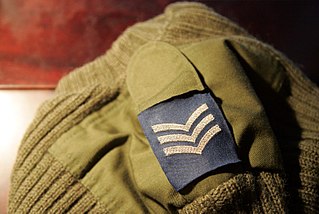
A shoulder mark, also called a rank slide or slip-on, is a flat cloth sleeve worn on the shoulder strap of a uniform. It may bear rank or other insignia. A shoulder mark should not be confused with a shoulder board, a shoulder knot, or an epaulette, although these terms are often used interchangeably.
Star Trek uniforms are costumes worn by actors portraying personnel of a fictitious Starfleet in various television series and films in the Star Trek science fiction franchise. During the various series, the costume design has often changed to represent different time periods and for reasons of appearance and comfort. Sometimes different styles were deliberately mixed to enhance the sense of time travel or alternative universes.

The Royal Air Force uniform is the standardised military dress worn by members of the Royal Air Force. The predominant colours of Royal Air Force uniforms are blue-grey and Wedgwood blue. Many Commonwealth air forces' uniforms are also based on the RAF pattern, but with nationality shoulder flashes. The Royal Air Force Air Cadets wear similar uniforms.

The uniforms of the United States Air Force are the standardized military uniforms worn by members of the United States Air Force to distinguish themselves from the other services.
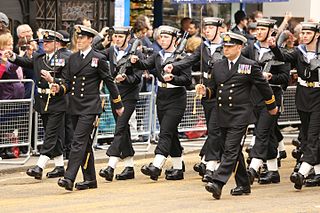
The uniforms of the Royal Navy have evolved gradually since the first uniform regulations for officers were issued in 1748. The predominant colours of Royal Navy uniforms are navy blue and white. Since reforms in 1997 male and female ratings have worn the same ceremonial uniform.

Type 07 is a group of military uniforms used by all branches of the People's Liberation Army (PLA) of the People's Republic of China (PRC) and the paramilitary Chinese People's Armed Police Force. Introduced in 2007, the Type 07 uniforms replaced the Type 87 service uniforms used by regular units and the Type 97 Service Dress uniforms of the People's Liberation Army Hong Kong Garrison and the People's Liberation Army Macau Garrison. The Type 07 uniforms were first seen in late June 2007 during a celebration ceremony for the 10th anniversary of the Transfer of sovereignty over Hong Kong.
The uniforms of the United States Army distinguish soldiers from other service members. U.S. Army uniform designs have historically been influenced by British and French military traditions, as well as contemporary U.S. civilian fashion trends. The two primary uniforms of the modern U.S. Army are the Army Combat Uniform, used in operational environments, and the Army Green Service Uniform, worn during everyday professional wear and during formal and ceremonial occasions that do not warrant the wear of the more formal blue service uniform.
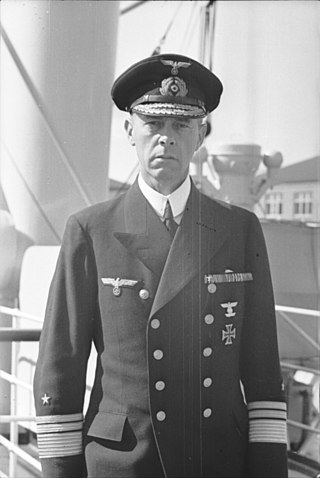
The Kriegsmarine was the navy of Nazi Germany prior to and during World War II. Kriegsmarine uniform design followed that of the preexisting Reichsmarine, itself based on that of the First World War Kaiserliche Marine. Kriegsmarine styles of uniform and insignia had many features in common with those of other European navies, all derived from the British Royal Navy of the 19th century, such as officers' frock coats, sleeve braid, and the "sailor suit" uniform for enlisted personnel and petty officers.
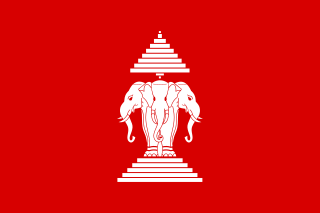
The Royal Lao Navy was the naval component of the Royal Lao Armed Forces (FAR), the official military of the Royal Lao Government and the Kingdom of Laos during the Laotian Civil War between 1960 and 1975.

The Royal Marines uniform is the standardised military dress worn by members of the Royal Marines.

The extensive system of uniforms of the Russian Armed Forces was inherited from the Soviet Armed Forces and modified across the years.
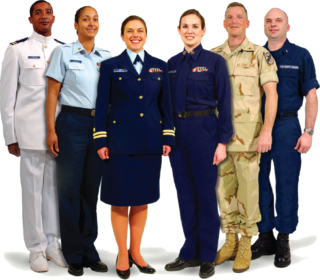
The Uniforms of the United States Coast Guard include dress uniforms, daily service uniforms, working uniforms, and uniforms for special situations, which have varied throughout the history of the USCG.



















